The heros of the day where two students they never flight before and one who with fear to fly.
At 7:20 we arrived at shipol-Amsterdam.
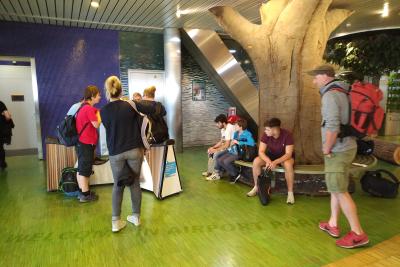
At the airport we refill our accus and that from smartphones.

At 9:30 the next flight to Graz (Austria) lift off.

At ten fourty we pass the line to Austria at Graz Airport.
After cold hours in Amsterdam we found the sun and warm in Graz.
Our friends welcome us with self painted letters and laughing in there faces.
After a happy and cordial ambrased we ws brought with there mini bus to Drava youth hostel in Maribor.
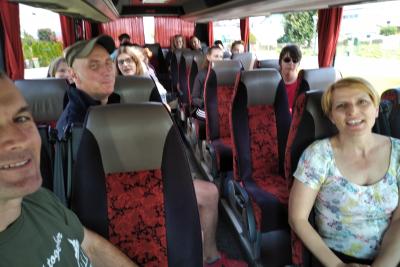
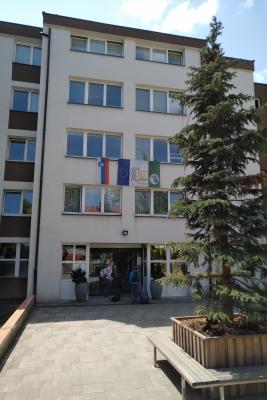
We got a historic walk through out the old town Maribor down to the Drava up to the passage and higher to the centralpark of Maribor.
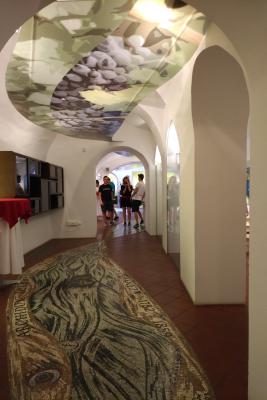
Down by the riverside is the house with the oldest wine of the world.
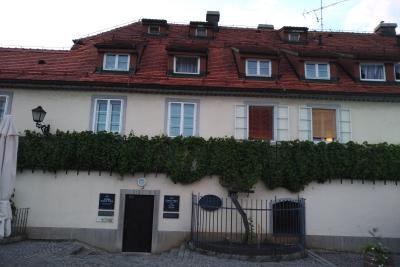
In school orchard we have two offshoots of them.

We go up to the market place with town hall.
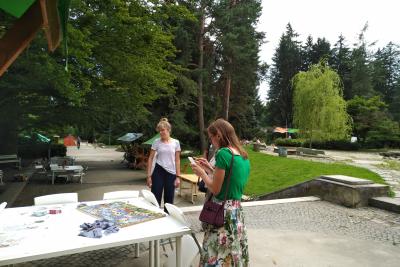
We visited and relaxed in the central park and found some stalls with hand crafted items.
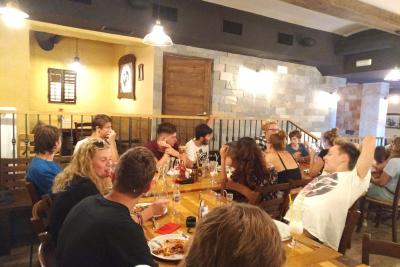
Back in town we had our dinner.

The weather was warm, a little clowdy sometimes but there was a rain machine which gave us a little coolness.

If the night is coming the atmosphere of the town goes smoochy.
And more deeper the night at the house goes more ghosts around.
... link (0 Kommentare) ... comment
The last days of sun and a weekend with rain brought new energiy to our plants. The fruit trees to bear growing fruits.
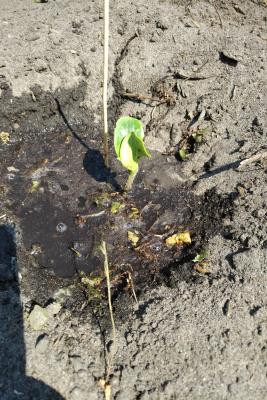
This photo show our pumkin schoot last week.
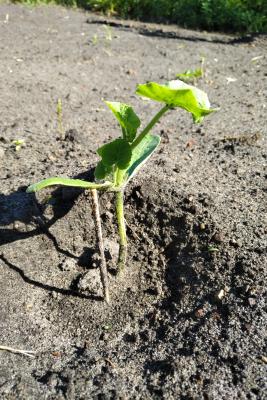
The pumkin schoot to day. It had the first leaves.

We clean up the pumkin field from wild herbs and watering the pumkin schoots

We set up the crown at our natural stone wall. In this time we saw; a mouse (Microtus arvalis) run out of the stones, differnt kind of vespes (e.g.Latibulus argiolus, Ichneumonidae). Lats one put it`s eggs inside other insects. Butterflys (e.g. Inachis spec.).
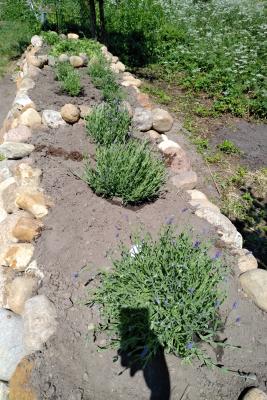
We planted to day as crown; Lavandula angustifolia, Rosmarin (Rosmarinus officinalis) and Koriander (Coriandrum sativum). This kind of herbs will be using for tea and cockies.
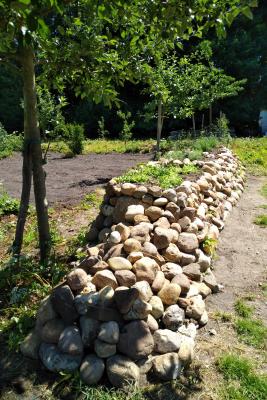
At the both narrow sides of the natural stone wall we constructed lengthening of poor stones for reptiles and small mamalias (e.g. Anguis fragilis).
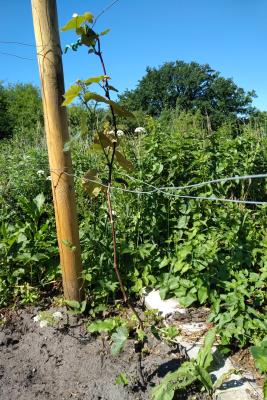
The vine growing and also the wild herbs wich we removed because of it`s concurence of water and light.

Last week we only had buds at our vine plants.
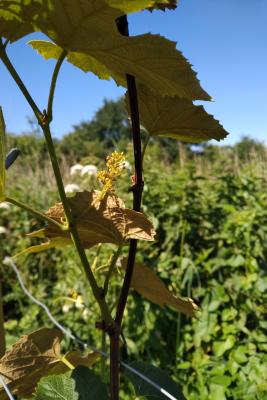
Today it had blossoms.
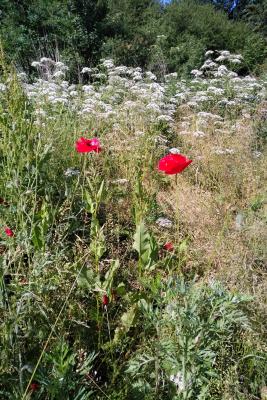
We let space for wild herbs to save bio diversity.
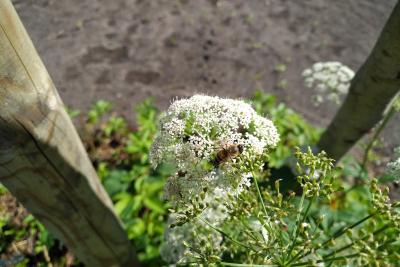
The wild herbs especially the Giersch (Aegopodium podagraria) is a wonderful larder for insect particularly for the honey bees (Apis mellifera)

Our heros of gardening at the last months.
We are glad and in exciting anticipation of our journey to Maribor (Slovenia) in the following week!!!!!
We wish all of you and us after all an amazing summer holidays!
... link (0 Kommentare) ... comment
the highest temperature in this may was 32 degree. In the last yeears e.g. last 20 years was the highest temperature 27 degrees. That are different about 5 degrees. It`s one more example of the extremly differents weatherphenoms in pasted years.
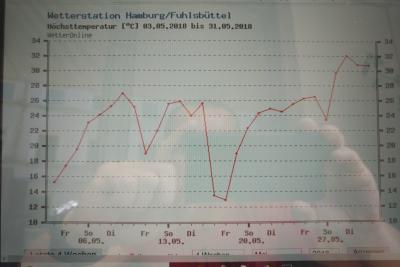
https://www.wetteronline.de/wetterdaten/hamburg?pcid=pc_rueckblick_data&gid=10147&pid=p_rueckblick_diagram&sid=StationHistory&iid=10147&month=05&year=1997&period=4&metparaid=TXLD
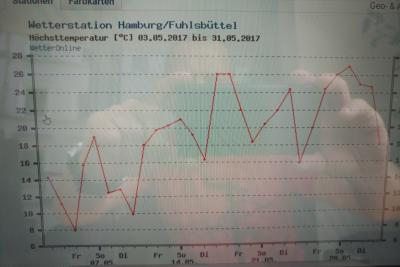
https://www.wetteronline.de/wetterdaten/hamburg?pcid=pc_rueckblick_data&gid=10147&pid=p_rueckblick_diagram&sid=StationHistory&iid=10147&metparaid=TXLD&period=4&month=05&year=2017
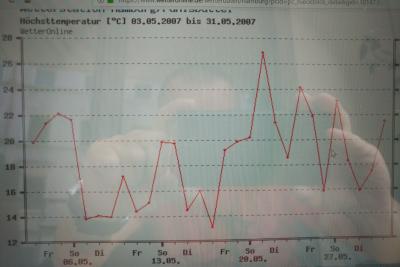
https://www.wetteronline.de/wetterdaten/hamburg?pcid=pc_rueckblick_data&gid=10147&pid=p_rueckblick_diagram&sid=StationHistory&iid=10147&metparaid=TXLD&period=4&month=05&year=2007
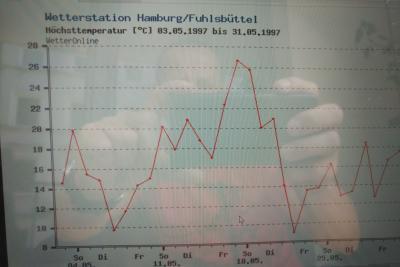
https://www.wetteronline.de/wetterdaten/hamburg?pcid=pc_rueckblick_data&gid=10147&pid=p_rueckblick_diagram&sid=StationHistory&iid=10147&metparaid=TXLD&period=4&month=05&year=1997
We can see how different the middle of data scale lies before 10 years near by 20 degrees. I the passt 10 years it was climbing average nearly two degree, so was the middle by 22 degree and than by 24 degree in the past years.
The coldest tempeartures 20 years ago around four degrees. Last year, a very weet year, we had at the beginning of the month temperature by and under zero degree. The other years only trough the months around 4 degree.
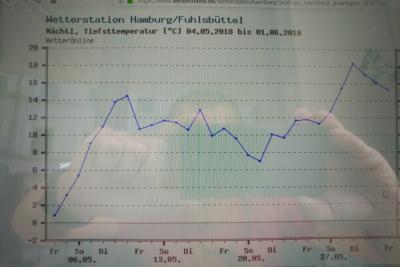
https://www.wetteronline.de/wetterdaten/hamburg?pcid=pc_rueckblick_data&gid=10147&pid=p_rueckblick_diagram&sid=StationHistory&iid=10147&metparaid=TNLD&period=4&month=05&year=2018

https://www.wetteronline.de/wetterdaten/hamburg?pcid=pc_rueckblick_data&gid=10147&pid=p_rueckblick_diagram&sid=StationHistory&iid=10147&metparaid=TNLD&period=4&month=05&year=2017
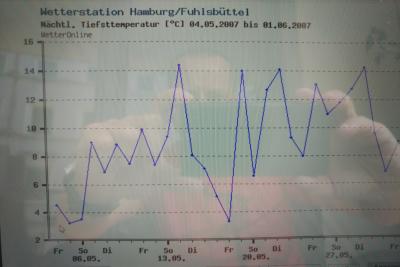
https://www.wetteronline.de/wetterdaten/hamburg?pcid=pc_rueckblick_data&gid=10147&pid=p_rueckblick_diagram&sid=StationHistory&iid=10147&metparaid=TNLD&period=4&month=05&year=2007

https://www.wetteronline.de/wetterdaten/hamburg?pcid=pc_rueckblick_data&gid=10147&pid=p_rueckblick_diagram&sid=StationHistory&iid=10147&metparaid=TNLD&period=4&month=05&year=1997
The middle of temperatures was around 8 degrees but the often under that line. Only in 2017 it was colder. But the tendency going up.
The hail was also a phenomenon. This may in 2018 wass very dry. We had only four days with high grad of rain.
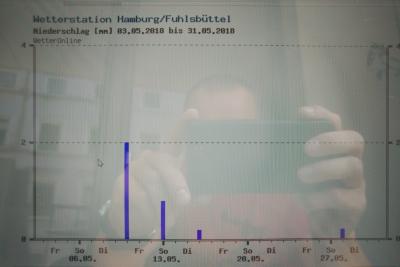
https://www.wetteronline.de/wetterdaten/hamburg?pcid=pc_rueckblick_data&gid=10147&pid=p_rueckblick_diagram&sid=StationHistory&iid=10147&month=05&year=2018&period=4&metparaid=RR24

https://www.wetteronline.de/wetterdaten/hamburg?pcid=pc_rueckblick_data&gid=10147&pid=p_rueckblick_diagram&sid=StationHistory&iid=10147&metparaid=RR24&period=4&month=05&year=2017
In this year 2017 we had 13 days with hail. But it had not so high grad like this year 2018.
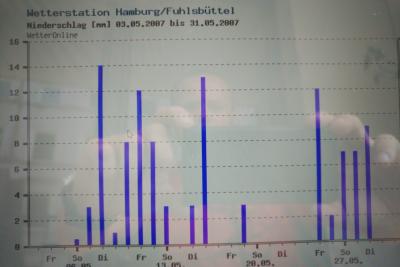
https://www.wetteronline.de/wetterdaten/hamburg?pcid=pc_rueckblick_data&gid=10147&pid=p_rueckblick_diagram&sid=StationHistory&iid=10147&metparaid=RR24&period=4&month=05&year=2007
In the year 2007 we had 16 days of hail.

https://www.wetteronline.de/wetterdaten/hamburg?pcid=pc_rueckblick_data&gid=10147&pid=p_rueckblick_diagram&sid=StationHistory&iid=10147&metparaid=RR24&period=4&month=05&year=1997
In 1997 and the years up to 2016 had more days with hail. Last year the hail lying in highest numbers around 14 Millimeter per squaremeters. Last year was one day with 32 mm. But the other days lying between 1 and 9 Millimeters. This year at the fiew days of hail there was only a maximum of 2 Millimeter per squaremeter.
We have a tendency to more dry years.
Lasst year we can`t planted our pumkinschoots before June because the nights had temperatures by night under 10 degrees. This year it was possible to planted in May. We where only late because of the examinations of our students.
... link (0 Kommentare) ... comment
A year later we can dig the well deep enough for the ground water. Since this time we have allways a little of water inside and enough for the life. In the last three years the life at the well had a detonate growing.

Our new well 2014
You can see that at the shores around the well the life don`t started.
By this time a lot of poeple used the well as litter box.
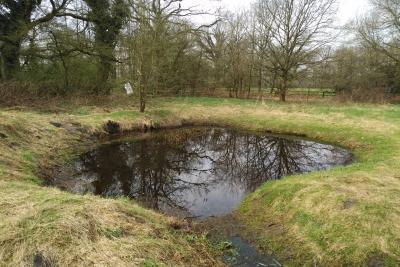
Our well now in spring. The whole years it was full of water. You saw that the frogs let there it`s eggs.
the shores are green but you cant`see the water plants because it`s leafs are at this time not outside the water.
Now after four weeks with temperature between 24 and 33 degrees with a drop of rain. you can see the litter and the plant and also the animals. The pollywogs get the first legs at the rearbody and the prick go shorter.
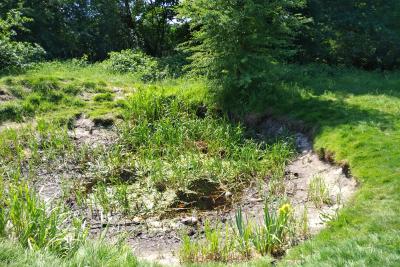
the actually water level is generated from ground water.
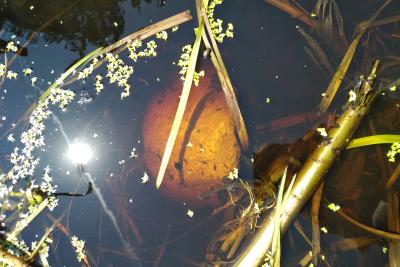
You can see also a water earphone.
I`ve you look right at the leaf in the middle, you can see a dragonfly (Zarte Rubinjungfer – Ceriagrion tenellum)

One highlight in time we cleaning up the well, was that nice following animal. Years ago it was brought from ducks. Now it having it`s own family. The piscicola geometra.
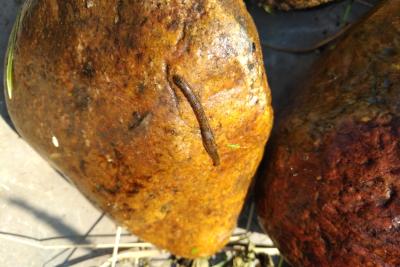
... link (0 Kommentare) ... comment
We started last week to cut the wildflowers on our potato field.

Today we leafed a parts of the hay and dig the field.

After all we plant schooted potatos.
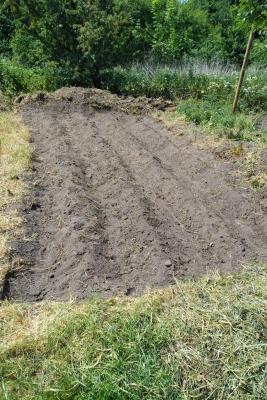
Normally it´s need water, but we don`t have no water spring at our Orchard. We bring the water in bottles there. Our water we used for the pumkin seedings and the vine.
We hope that the weatherreport will be right and we get rain.
Inside the soil lines are the potatos.
... link (0 Kommentare) ... comment
Aftewr the fished exams we had tim e to work hard on our Orchard and we have a lot to do.
In a second wave we sowing the pumkin seeds.
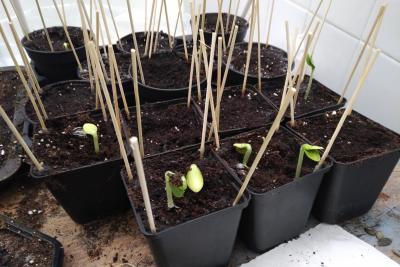
This week the schoots where high enough. When the seed stems lie on the edge of the pot, they become rotten and the seedling dies.
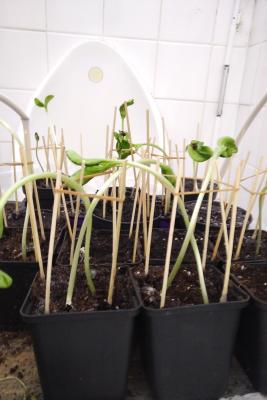
For this reason we have stretched elastic bands around sticks.
Last week it`s was to small for the garden and the gardenbed was not already.
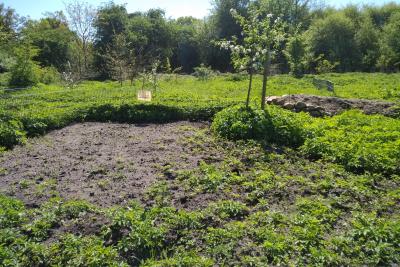
Our students work hard to get a bed free from goutweed (Aegopodium podagraria).
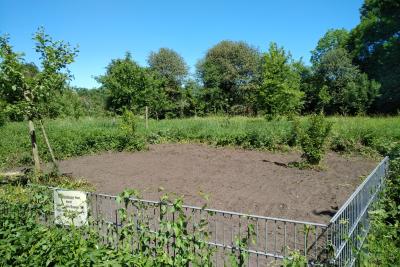
Today we planted the pumkinschoots in the gardenbed after cleaning was finished.

They superimpose the schoots in the bed.

A ring of soil save the freshwater for the schoots.
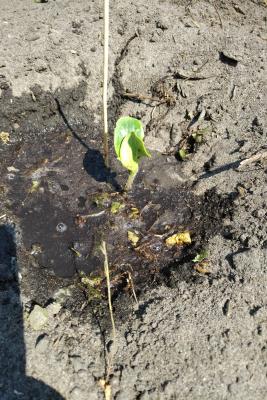
Also the stonewall growed and had nearly finished last week.
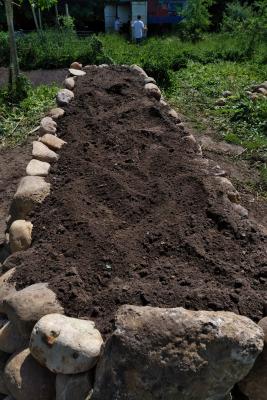
This week the temperature higher than last week, but the students worked hard to day.
They set the wall apart for planting south european herbs.
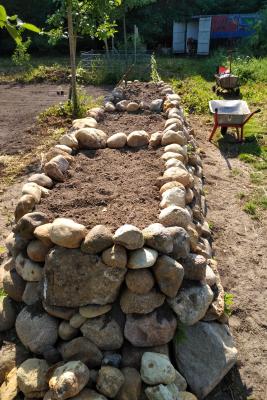
The wall was filled up to the highest level with cleaned soil.
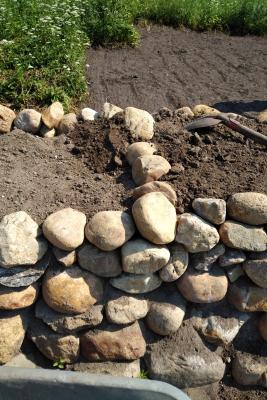
... link (0 Kommentare) ... comment
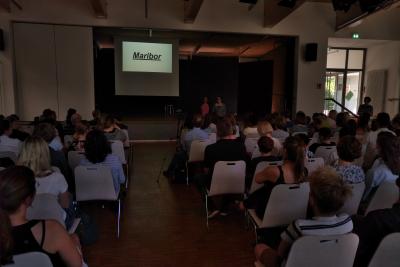
This presentation is for the next Generation of Start-Up students in school year nine with the begining after the summer holiday 2018.

In the auditorium sitting Students, Teacher and parents.
... link (0 Kommentare) ... comment
Actually it`s a very important biotope in case there are not use of pestizids.
There life reptiles, insects like ants, bees, bugs, spiders inside. Also in case of that it`s a food place for birds and other animals. And at last the height make it as place for watching at food for birds.
We will plant there mediterran spice plants because the small climates of the make it possible. It`s warm and there is no waterlogging.
... link (0 Kommentare) ... comment
The examination weeks found end. Today we gone at our orchard. Our pumkin shoots must be inside our house because we had nights under 10 degree (see the weatherreport).
The wild green grow fast. Water in ground and a lot of sun and the nature explode.
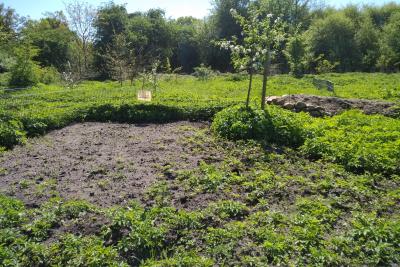
All our work we found under the new green.
Our work today was, to free the pumkin field and the vine and also let the natural stone wall grow.
The students are very powerful and full of happiness.
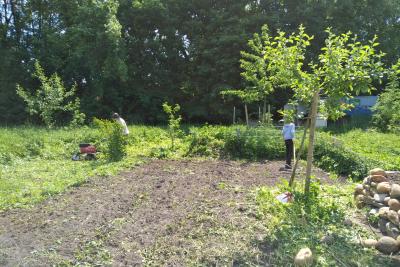
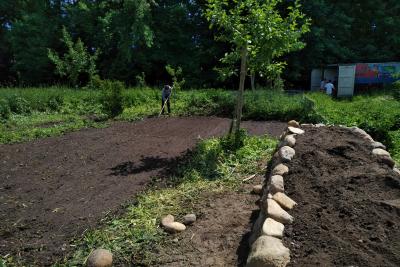
Now the pumkin field is free so that we can plant the shoots on next thurdays if the new grow fast.
In the other way the students get more feeling to build a natural stone wall.
All stones had it`s own history. Our stones are here in case of the last iceage. It´s rolling with the glacier from the north down to us took further to the south. Than the the world gone warmer, the glacier melted and borned the river Elbe trought the melting water. The stone rolling down with the river or get free from melted glacier in our sandy upland both side the river Elbe.
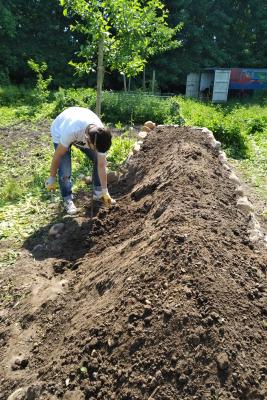
The farmer of the north of germany find/found the stones at there fields. Where it to be left, there don`t grow arable crops and the agriculture device got broken.
In this way the farmer bring the stones outside and beside there agriculture fields.
Over hundred of years this kind of natural stone walls was build all over north germany between the east and the west coast. Now it`s build a very importend part of north germany agriculture history and is very important to save rare Flowers, insects and animals. In the last three decades it was forbidden to bring out pestizids against wild flowers at the edge of the field.
We build the wall at the ground with the biggest stones as foundation. The upper stones are smaller but they have to lie alone one the foundation stones. We don`t use any concrete or other devices. We lie the stones so narrow as possible and there don`t will be big slots with space for soil. In this case its secure the upper flower patch from wild flowers.
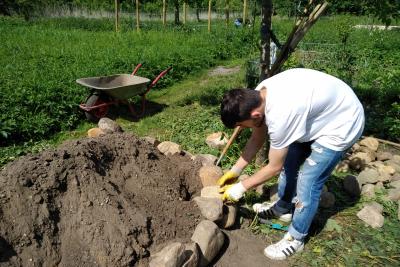
After the first stacks we fill the soil in to stabilized the wall.
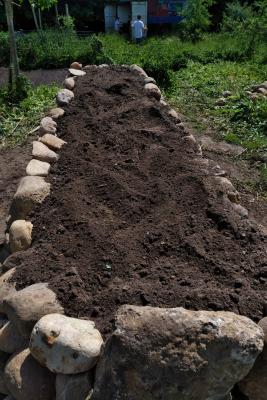
We had finished today e.g.60% of the stone wall. It will be finished if it get a height from 1,20 meters.
After all we hope that we can plant mediterran flowers like Thymiane, salvia and Rosmarinus officinalis.
All this plants we will use for tea and spice for our potato chips.
Also will life between the stones small insects, spiders, bees. The stones get warm from sun and in this case it`s interesting for reptiles. For birds and other animals it is like a restaurant.
Our last building site today was clean up the vineyard from wild flowers. You see it works.
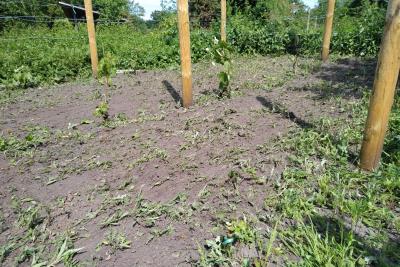
Our new plants of vine started slowly but it life. The plants from last year started faster.
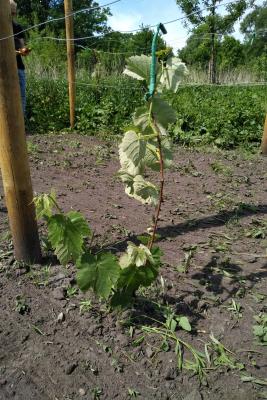
the free plant have now space to grow and no compittor around water, light and minerals in ground.
... link (0 Kommentare) ... comment

highest temperatures April 2018
https://www.wetteronline.de/wetterdaten/hamburg?pcid=pc_rueckblick_data&gid=10147&pid=p_rueckblick_diagram&sid=StationHistory&iid=10147&metparaid=TXLD&period=4&month=04&year=2018
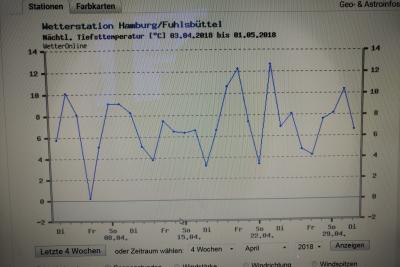
the lowest temperatures 2018
https://www.wetteronline.de/wetterdaten/hamburg?pcid=pc_rueckblick_data&gid=10147&pid=p_rueckblick_diagram&sid=StationHistory&iid=10147&month=04&year=2018&period=4&metparaid=TNLD
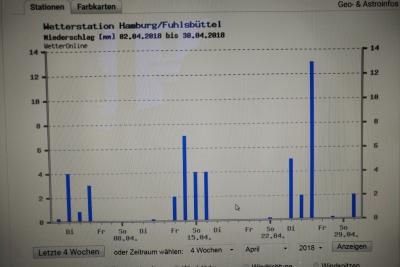
hail in April 2018
https://www.wetteronline.de/wetterdaten/hamburg?pcid=pc_rueckblick_data&gid=10147&pid=p_rueckblick_diagram&sid=StationHistory&iid=10147&month=04&year=2018&period=4&metparaid=RR24
If we take a look at the haildays we see, that last year was very wet with maximum days 20 with hail. Also this days had a large amount of water. This year and last year had days with 13 mm Rainfall. The last decades had maxium by 10 mm per day.
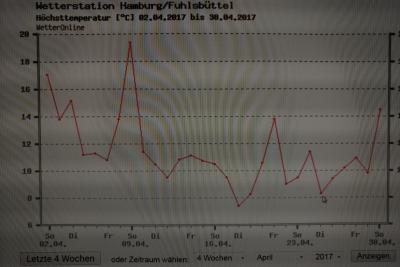
highest temperatures in 2017
https://www.wetteronline.de/wetterdaten/hamburg?pcid=pc_rueckblick_data&gid=10147&pid=p_rueckblick_diagram&sid=StationHistory&iid=10147&metparaid=TXLD&period=4&month=04&year=2017
If we look at the highest temperature trough the last decades we can see that the temperature rise from year to year. The highest temperature this year in april was 27 degree. In 2017 only 19 but it wa sa rany month. In 2007 we had 18 degree as hih as possible. In 1997 we had only 16 degree as the highest temperature.

lowest temperature 2017
https://www.wetteronline.de/wetterdaten/hamburg?pcid=pc_rueckblick_data&gid=10147&pid=p_rueckblick_diagram&sid=StationHistory&iid=10147&month=04&year=2017&period=4&metparaid=TNLD
The lowest night temperatures are waving between -,2 and zero degrees in the decades. the same effect we can see by the highest temperature in the wave of lowest temperatures. They wave over the decades between 7,9 degree and 12 degree.In small step get the count of peaks in the waves up. from 7 in 1997 to 10 and 9 in 2017/18. The peaks by the highest temperature gone more less. Whereas in 1997 10 days with rising temperatures are in 2017/18 less like 9 and 8 peaks.
The current trend is, that the different between the lowest temperatures per days at month raised. If we get the highest low temperature in 2018 and the highest day temperature at the same year, we see 14,7 degree different. In 1996 that are only 5,8 degree.
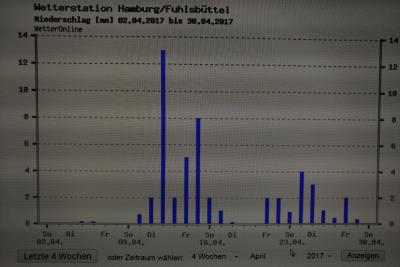
hail April 2017
https://www.wetteronline.de/wetterdaten/hamburg?pcid=pc_rueckblick_data&gid=10147&pid=p_rueckblick_diagram&sid=StationHistory&iid=10147&month=04&year=2017&period=4&metparaid=RR24
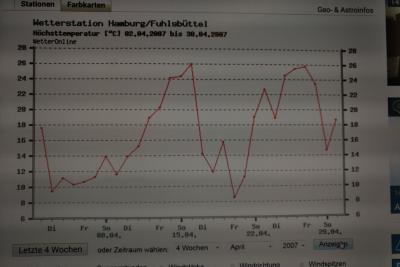
highest temperatures April 2007
https://www.wetteronline.de/wetterdaten/hamburg?pcid=pc_rueckblick_data&gid=10147&pid=p_rueckblick_diagram&sid=StationHistory&iid=10147&metparaid=TXLD&period=4&month=04&year=2007
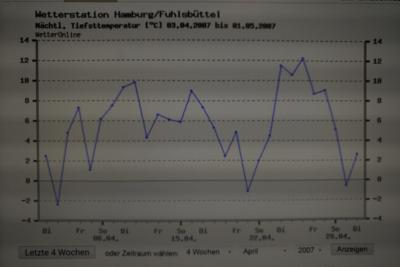
lowest temperatures April 2007
https://www.wetteronline.de/wetterdaten/hamburg?pcid=pc_rueckblick_data&gid=10147&pid=p_rueckblick_diagram&sid=StationHistory&iid=10147&month=04&year=2007&period=4&metparaid=TNLD
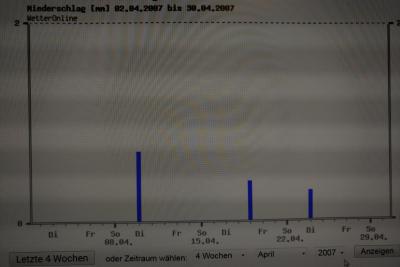
hail April 2007
https://www.wetteronline.de/wetterdaten/hamburg?pcid=pc_rueckblick_data&gid=10147&pid=p_rueckblick_diagram&sid=StationHistory&iid=10147&month=04&year=2007&period=4&metparaid=RR24
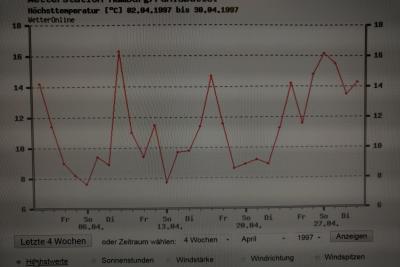
highest temperatures April 1997
https://www.wetteronline.de/wetterdaten/hamburg?pcid=pc_rueckblick_data&gid=10147&pid=p_rueckblick_diagram&sid=StationHistory&iid=10147&month=04&year=1997&period=4&metparaid=TXLD
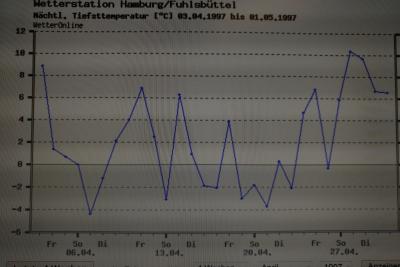
lowest temperatures April 1997
https://www.wetteronline.de/wetterdaten/hamburg?pcid=pc_rueckblick_data&gid=10147&pid=p_rueckblick_diagram&sid=StationHistory&iid=10147&month=04&year=1997&period=4&metparaid=TNLD

hail April 1997
https://www.wetteronline.de/wetterdaten/hamburg?pcid=pc_rueckblick_data&gid=10147&pid=p_rueckblick_diagram&sid=StationHistory&iid=10147&metparaid=RR24&period=4&month=04&year=1997
... link (0 Kommentare) ... comment
Why Slovenia - Celebrate World Bee Day?
What do people around the world know about Slovenia(n) Bees?
https://www.worldbeeday.org/en/about/why-slovenia.html

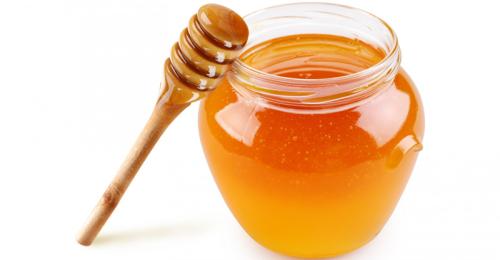
Students are learning about the importance of the bees in several subjects: Environmental vocational subjects, Beekeeping and English.
beekeeping_dictionary (pdf, 203 KB)
There is a lot of material on internet to learn about the bees and beekeeping in the classroom. However, it is definitely better outside with the hands on learnig at our school beehive
https://www.betterbee.com/glossary/
http://www.bushfarms.com/beesterms.htm
... link (0 Kommentare) ... comment
On Monday, we washed all the equipment and prepared all the accessories, and on Tuesday, 8. 5. 2018, we were first time harvesting our school honey.

Nikita, Ivan, Jacob, and Mihej removed the top and smoke the opening to drive the bees lower into the hive. They took the frames from the hive. They removed any lingering bees from the frames with a bee brush. They set them aside into a plastic container with a lid.
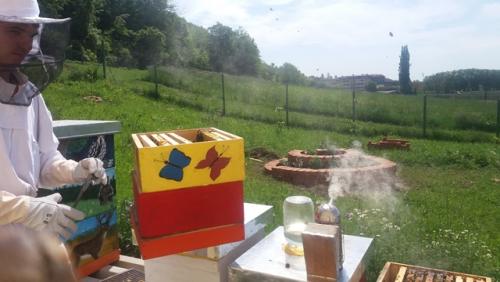

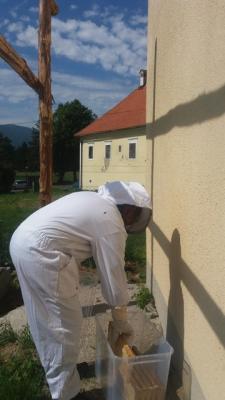
These containers with lids were taken to our beekeeping classroom. The girls at the special table uncap the wax-sealed honeycomb using an uncapping fork on both sides of the frame.

They placed the frame into a honey extractor and spined the frames, forcing the honey to the walls of the drum where they drip to the bottom. They opened the spigot and strain the honey through several layers of strainer to remove any stray bits of wax or other debris.
The boys put the frames back into the hive. We were harvesting about 20 L on honey.
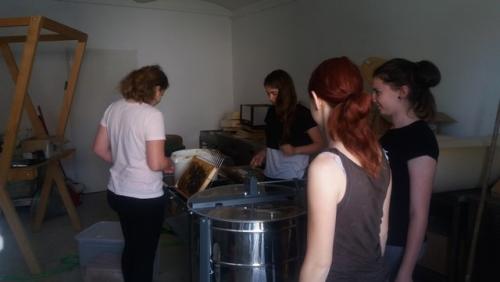
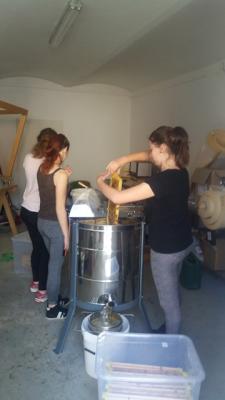
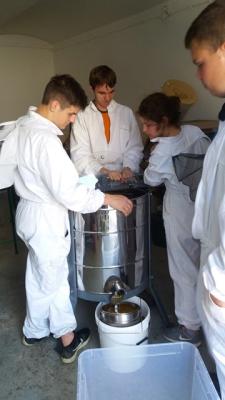
We let the honey lie down. After three and ten days we removed the impurities (wax residues) that drove to the top of the honey.
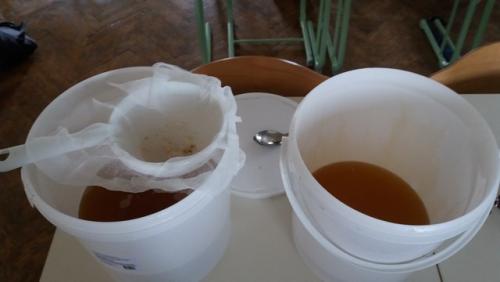
On Wednesday, 9. 5. 2018, we were also harvesting honey from the hives of the Educational Center Piramida Maribor. We did it according to the same procedure and drained 5 L of honey from one hive.
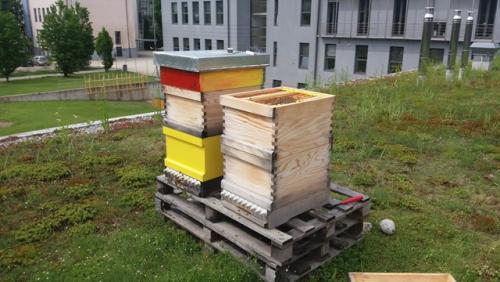
The removed wax cappings were stored together with some honey in a special container and poured with school brandy. This was left for 4 days, then the mixture was passed through the strainer and gauze and filtered through the filter paper. So we got the first school honey liqueur.
When the honey was clean and we removed all wax residues, we pored it in glasses and seales them. We also marked the glasses with stickers.

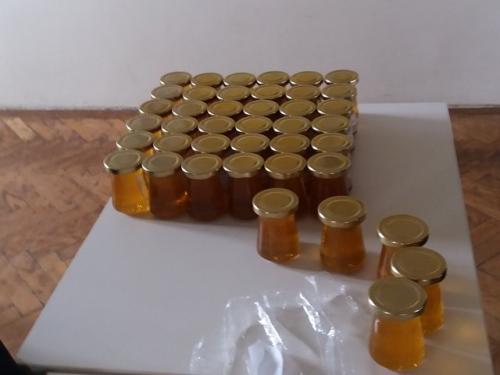
From last year's honey produced by bees from the Education Center Piramida Maribor, we made whipped honey with ginger and whipped honey with chocolate and pollen. We also filled this honey into glasses and marked them with stickers.


One week after harvesting we found our first swarm on a small peach. With the most faithful beekeeping team (Ivan, Jakob, Mihej and Nikita) we caught the swarm in a wooden crate, closed it and left for one day in a cool and dark place.
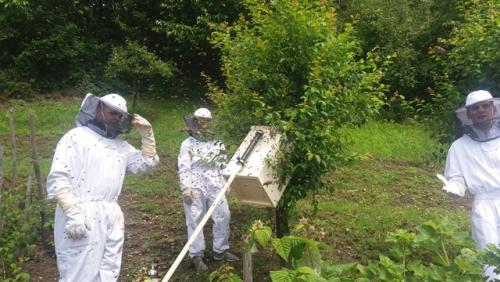
Then, the swarm was treated by spraying 4.2% of the oxalic acid solution in order to eliminate the potential Varoa. Swarm was than settled in a new hive. We added it some food in the form of a sugar solution.
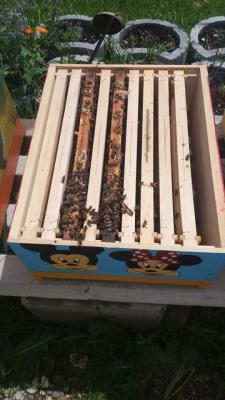
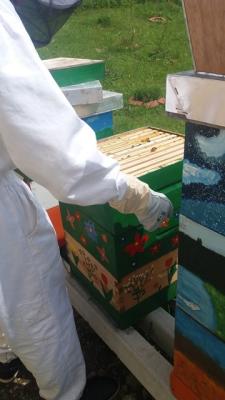
We also ordered new Queen bee and made new bee colony.
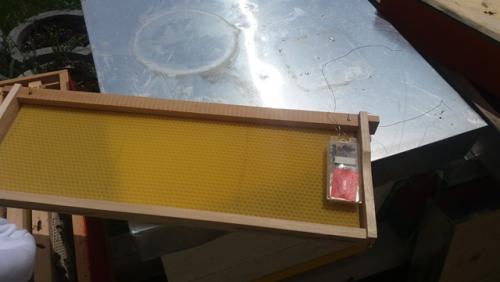
The girls continued coloring the hives and assembling frames.
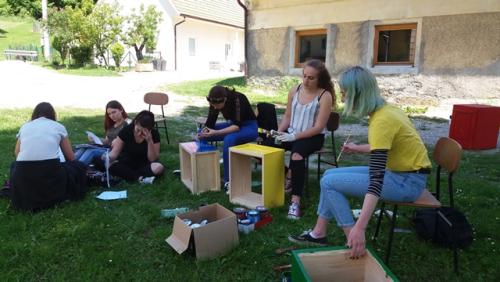
... link (0 Kommentare) ... comment
They searched information about the position and the size of the city, the number of the population, their legal system, compared the population growth in Hamburg and Maribor, found the proportion of the population by sex, compared the natural increase in both cities, learned the structure of the population in Hamburg, learned the economic and media power of Hamburg , talked about tourism in Hamburg, met the path of the river Laba (Elba) from the source to the estuary and met the new city district of Hamburg (Hafencity).
They quickly found out that Hamburg is one of the most important cities in Germany, even in Europe. The population is almost as much as in the whole of Slovenia. In Hamburg, there are more men than women living in, and the opposite is true in Maribor. The natural increase is positive in Hamburg, which means that the population is rising. In Maribor, the natural increase is extremely negative.
Hamburg is economically very powerful. The main drivers of development are the port, which is the third largest in Europe, the aviation industry, heavy industry (steel, aluminum and copper) and rapidly developing tourism. It is very strong banking, which has a long tradition in the city. Media (printed, music, TV and radio) are also important in the city.
In order to make it easier for students to understand why Hamburg has evolved so quickly through history, the Labo (Elba), which is the main culprit for the boom of the city itself, had to learn about it.
In the end, they found out the part of Hamburg, which is probably the most famous one - Hafencity. Hafencity is an example of the modern development of the city, where the residential and business part intertwines. The main focus is on sustainable development and the use of modern technologies.
Considering what the students saw and heard about Hamburg, we could say that this is a very important place. But this is not a classic metropolis (concrete, concrete and concrete again), here you have the feeling that homeliness and modernity with a lot of greenery intertwine in one place. This can be confirmed by students attending an exchange in Hamburg.
hamburg_ang_verzija (pdf, 1,800 KB)
... link (0 Kommentare) ... comment
The average monthly temperature was also significantly higher than the average of the period from 1981 to 2010 – it was 15,14 °C, and it was 4,34 °C higher than the long-term average. The long-term average for April is 10.8 °C in Maribor. However, if we compare the average temperature of the second half of the month with the average of the period from 1981 to 2010, it was found that it was higher by as much as 13.77 °C.

In April, the daily average temperature was only four times below the average of the period from 1981 to 2010 (10.8 °C). The maximum temperature was twenty times above 20 °C, thereof eight days above 25 °C. The lowest temperature in April was 0 °C, and the highest temperature was 28.8 °C. In the first four months, the average temperature was 0.39 °C higher than the long-term average.
Precipitation during April was less than average. The measuring device detected 44 mm of precipitation, which is less than as long as the long-term average (60 mm of precipitation). In the first four months, was 64.4 mm more precipitation than the long-term average.
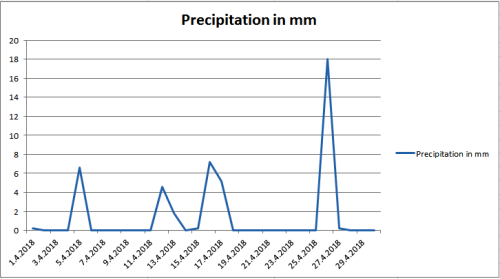
The average relative humidity in April was 62.22 %, which is 15.38 % less as in March. This was expected due to less precipitation.
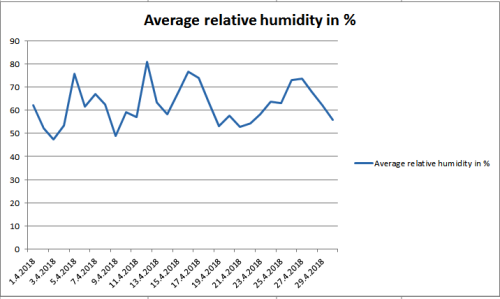
... link (0 Kommentare) ... comment
And yes, it`s works. You can find different and rare Butterflys, a duck had it`s nest in the gras. In our small lake we have leech, three different kind of dragongflys and a lot of grass frogs.

The spawn of grass frogs

Male and female grass frog. The upper one is the male.
This frogs will help save our culturplants because they live from insects.
And a lot of different plats help us to save water in the ground and give great insects like bees, spiders or butterflys a place to live, a children`s room and food.
Our vine and tress are thank it us.
The following pictures shows the same appletree between April and May 2018.
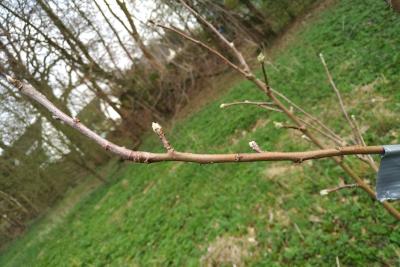
Apple tree at April 2018
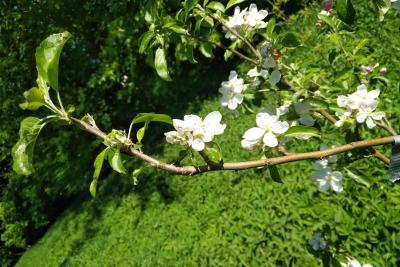
Appletree in May 2018
You can see the effect of sun and higher temperatures. The wildflowers save the water in ground, so the trees can use it.
The tree live together with mycelium which remove minarals from the ground and the water, so that the tree can use it for photosynthesis and by end to grow and build wood and apples or plums,...
Also it change the biochemical structure in the ground and let other differnt flower grow and live, which don`t grow here without the trees.

And the sun let the blossom bloom.
... link (0 Kommentare) ... comment
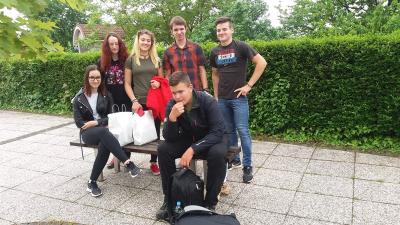
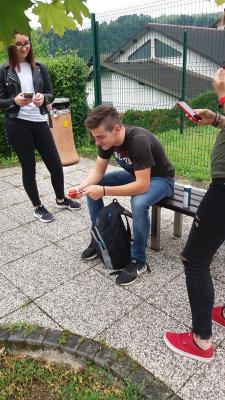
With such diverse range of activities, time passed quickly, because everyone could find something for him. Of course, the main purpose of all these activities was making friendships and exchange of experience. The Beekeeper Association, in cooperation with the gardener Trajnica Golob - Klančič, distributed seedlings of honey plants to all competitors and their mentors.
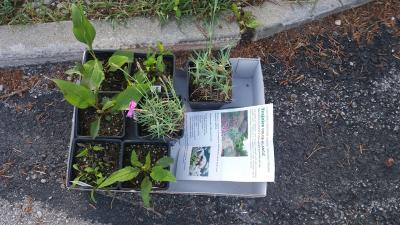
Hofer and Semenarna Ljubljana donated seeds of honey plants. After lunch the most important part of the competition were followed - announcement of results.
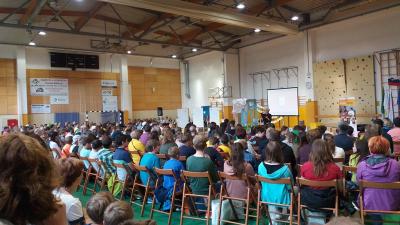

This year, for the first time, a final selection of the best beekeeping team was held. The final competition took the form of a quiz. The winners of the final round received a practical prize - beekeeping equipment as a contribution by sponsors.
Our students: Sara Vrečun, Michelle Vrbanić, Glunec Eva, Ivan Praznik, Jakob Pulko and Mihej Mukenauer received a silver award.
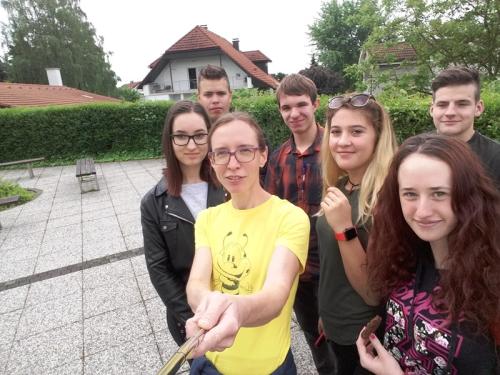
Congratulations to all students for their success, and I hope that next year we will see you again in Beltinci.
... link (0 Kommentare) ... comment
Mr. Bogdan has presented problems arising from the use of palm oil and paraffin wax candles. For the production of palm oil, huge tropical forests are cut out, and paraffin wax is made of oil. When burning paraffin candles, toxic toluene and benzene are generated. Therefore, use the paraffin candle as little as possible in enclosed spaces. We learned that wax candles are healthier for people, but they are more expensive.


Mr. Bogdan also showed us, how we can make a candle. For a simple candle, we need a glassware, water, waste cooking oil and wicks. So the candle is ready and just waiting to light it.
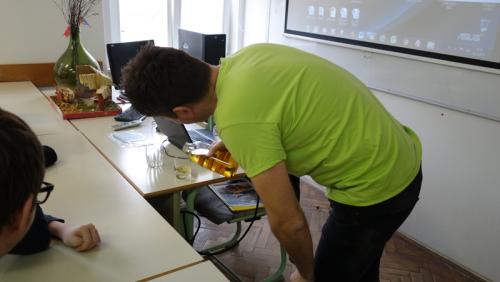
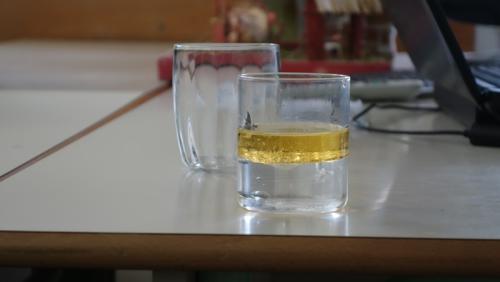



Because, we often do not know, where the oil remains after the preparation of lunch, the company decided that they could start producing candles from waste cooking oil. It is the only candle that is made from renewable sources, from waste material. The advantage of making such a candle is that we do not need dangerous chemicals for the manufacture, reduces the amount of discarded waste edible oil, allows the recycling of waste cooking oil at home, replaces an environmentally unfriendly paraffin candle and promotes the use of candles from a local source.

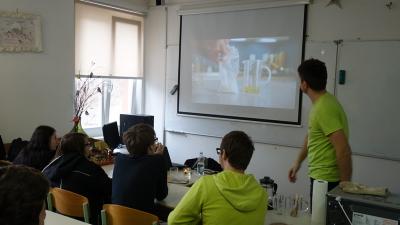
After the introductory part, the workshop was followed. The students were divided into three groups and each group could choose its smell and color of the candles. Thus, the smell of jasmine, mojito and roses spread throughout the candle making.
First, it was necessary to purify the waste edible oil,
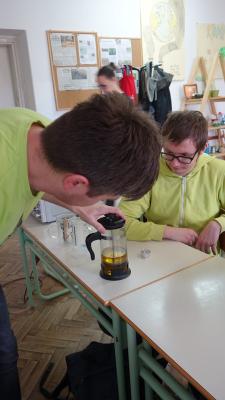
then the students accurately measured the amount of oil
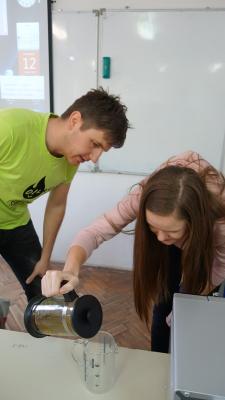

and mixed the powder made from vegetable substances into it.
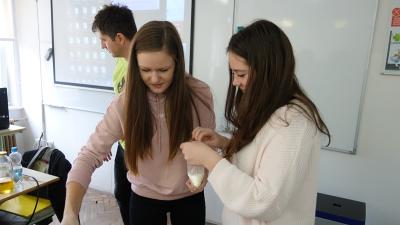
The mixture was placed in a microwave oven where it was heated.
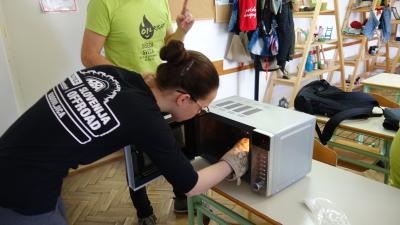
Finally, the powder was added to the desired fragrance and mixed. We quickly saw the changing of the color of the oil in green, blue and red.

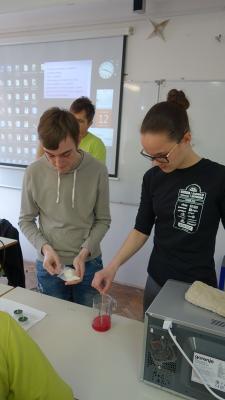
Meanwhile, the remaining members of the group prepared bins for candles and wickers. The colored mixture was finally poured into the bins
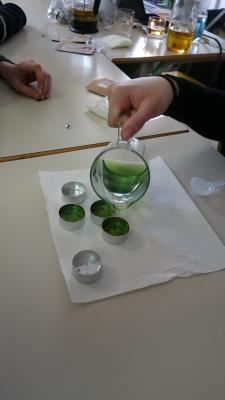

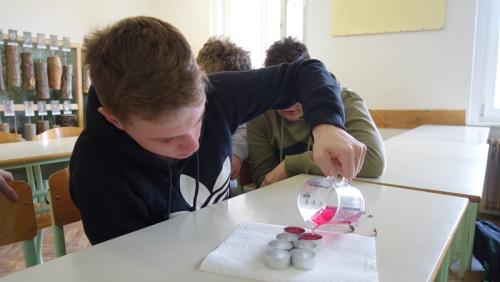
and allowed the candle to cool and solidify.
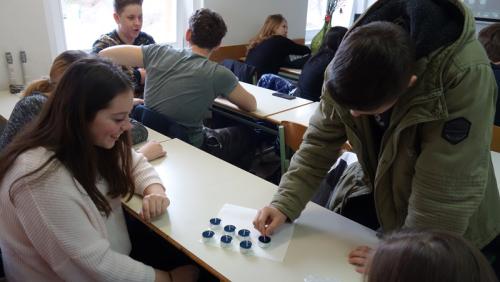
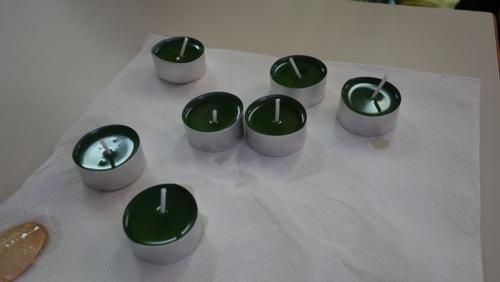
In a very simple and quick way, students came to their scented candles.
At the end of the workshop, everyone agreed that you did not even notice that waste edible oil was the basis for scented candles.
Well, a lot of fun at making these candles.
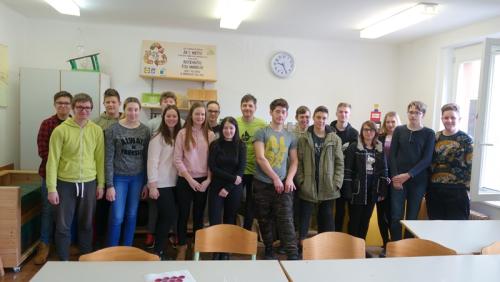
... link (0 Kommentare) ... comment
In the pheasant farm in Beltinci, we saw the breeding of pheasants and partridges. Everything begins with eggs that are disinfected before they are deposited in the hatchery. After the hatching, where the eggs turn, they are transferred to the another chamber where the chickens are hatched.
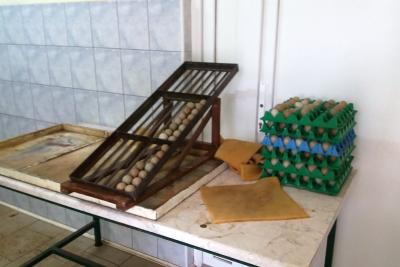
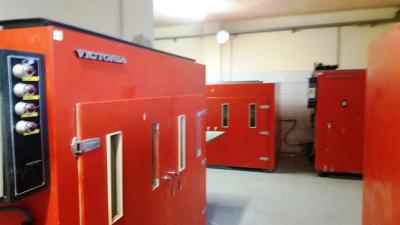
There are no small chicks in this season, so we could only see adult pheasants and quails. Some animals are sold to the hunting families, others are hunted.



After visiting the pheasant farm we went to the Beekeeping Tigeli in Prlekija. We arrived in a beautifully decorated Mediterranean garden surrounded by beehives.

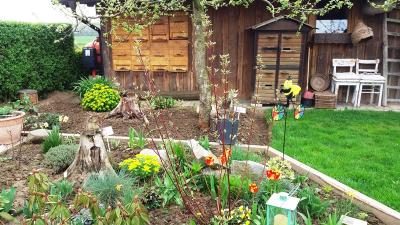
The Lady presented us their activities and briefly restored the basis of beekeeping. The beginnings of the Beekeeping Tigeli date back to the year 2001 when they bought the first bee colonies.
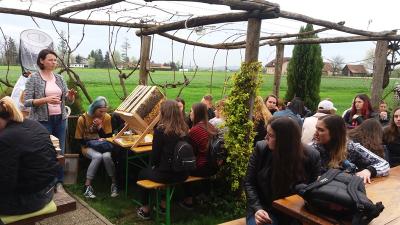
Now they have beekeepers with around 100 bee families - in two stationary beehives and three transport units. In 2005, they inherited a beekeeping museum and began intensively dealing with beekeeping tourism. In addition to the museum, there is a learning beehive where visitors can work on bees. There are many other museum collections of hives and beehives on their property.
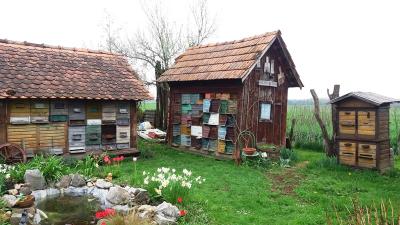
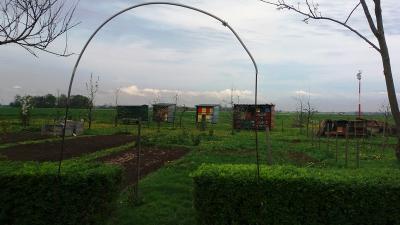
In front of the bee houses there is a beautifully landscaped Bee garden, and in front of their house there is display the life of bees in wooden honey combs. The most beautiful beehive, transformed into a museum, is an octagonal shape with a roofline.
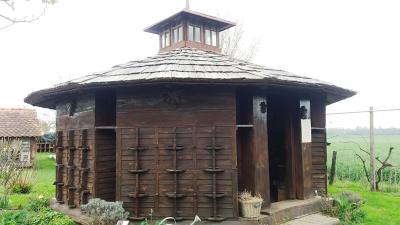

In the beehive, it was possible to beekeeping with 84 families, and the hives were made according to the Naiser system - a hot construction system. The octagonal beehive is still the only specimen in nature and is protected in the cultural heritage of Maribor as an ethnological monument. Various honey packs, hand smokers, wax presses, hives from different periods, a model for making combs, baskets, various literature about beekeeping and many other interesting tools are on display in the museum.


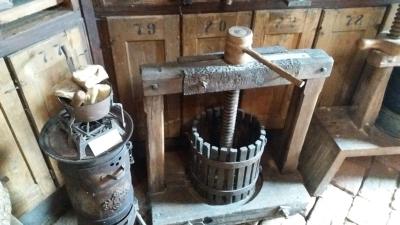
After a pleasant walk through the mediterranean garden and the museum apiary, we went to the our last station – apitourism of beekeeper Šemen Štefan.

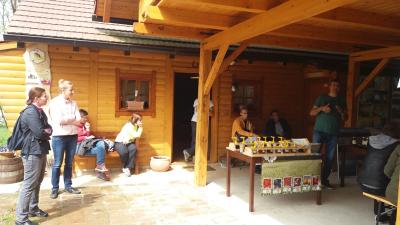
In this beekeeping they work with 700 bee families in the AŽ and DGB hives.

The bees are transported to various pastures throughout Slovenia. They produce all varieties of honey. In addition to selling honey and other bee products, they also offer apitherapy services. In the apiary intended for inhaling aroma of wax, honey and propolis, for visitors are prepared two beds and two comfortable chairs.

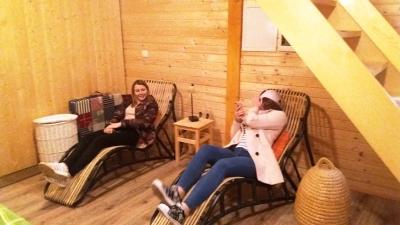
The pleasant space is smudged by an aerosol, which has a great apiterapeutic effect on people and works calming. Behind the apiary is a bedroom, a kitchen, a sauna and a larger space for socializing.
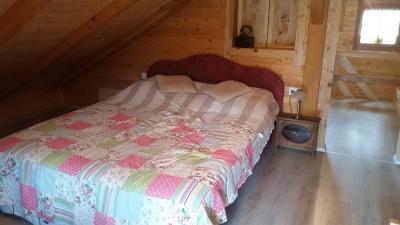
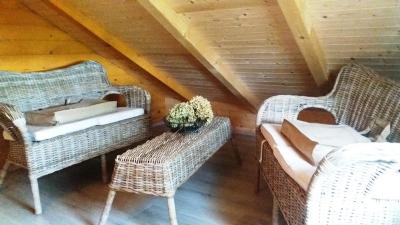
From the balcony above the apiary there is a beautiful view on the pond where the visitor can boats or fish. The beekeeper wisely and in on his own way presented his activity and how he managed to become such a big beekeeper.
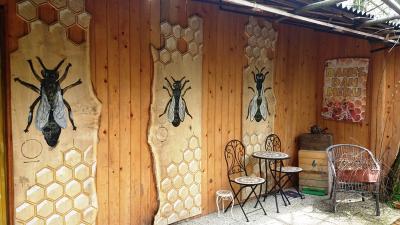
In both beekeepers, we could also taste some good bee products. Strengthened and revived from aerosol, we then set off with the bus to the home.
... link (0 Kommentare) ... comment
ApiGo is a complementary feed mixture containing glucose, maltoderin and yeast extract.
We mixed 20 g of powder with 1 L of water. The solution is dropped along the honeycomb frames. 50 ml of the solution is used in one hive.
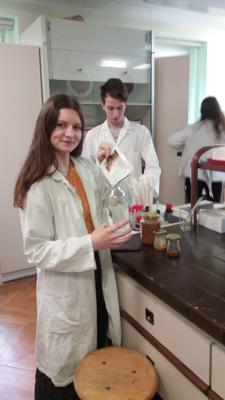
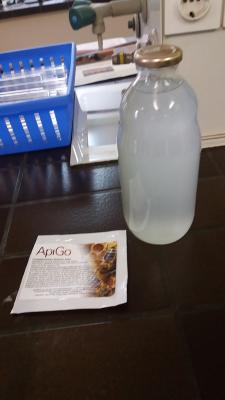

The Medopip sugar cake was laid on the honeycomb frames. In addition to sugar, this cake contain proteins and vitamins, which is a good for stimulation for the development of the bee's families.
Because the weather was bad in March, we also made the first detailed overview of the bee family in April.
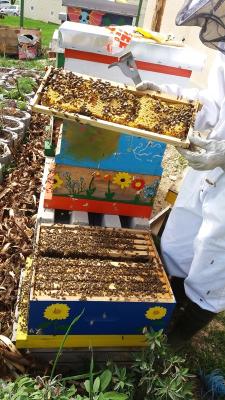
The bee queen began to lay eggs. Because the trees and flowers are blooming, the bees have already accumulated some stocks of nectar and pollen. The abundant flowering led the family to the swarm mood.
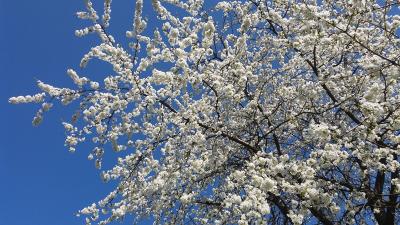
In order to avoid unnecessarily hunting newly born families around the school estate, we decided to make artificial new families – with bees, eggs, larvae, pupae, and honeycombs. So we have created two new hives from the five hives that survive winter.
We also started painting new hives
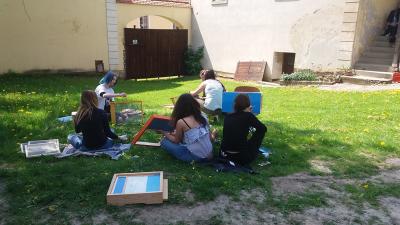
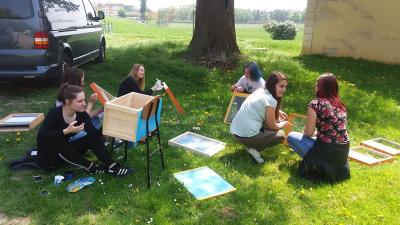
and preparing new honeycomb frames.


In bee garden we also planted several shrubs,
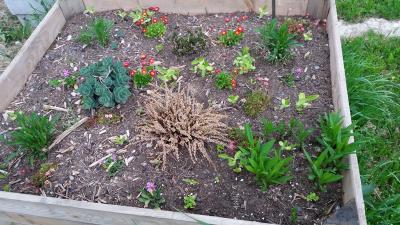
on the pergola we planted vines, wild vines and clematis.

We cut grass around trees and we sowed sunflowers, asters, zinnias, nasturtiums facelia and other honey plants.
... link (0 Kommentare) ... comment
Students competed in baking, cooking, writing art text, knowledge, visual art and photography. The main theme of this year's competition were pumpkin seeds and pumpkin oil.
Our students participated in the competitions. After the introductory speech, the students were divided into groups and assigned to their jobs. During the competition, the mentors had the opportunity to take a guided tour of Maribor. The hosts prepared a pyramid pot and dessert for all participants. We used the rest of the time for a pleasant socializing with friends and acquaintances.
And what did our students achieved?
In the COOKERY category, Lana Križanec competed with Risotto with pumpkin oil and salmon, and Jure Stošić with Pumpkin rissot. Lana was perfect and reached the fifth place and bronze award, and Jure was awarded the 9 th place and recognition for participation.

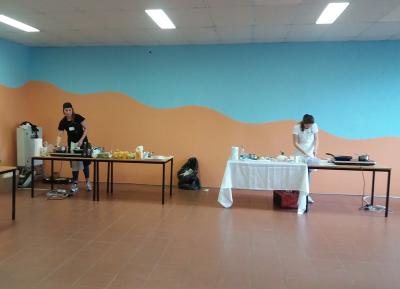
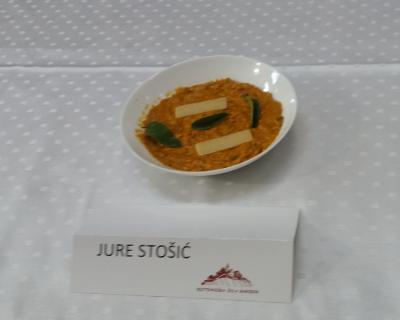

In the category FOODSTUFF, Mario Žebot achieved a golden confession with excellent Pumpkin Pie.

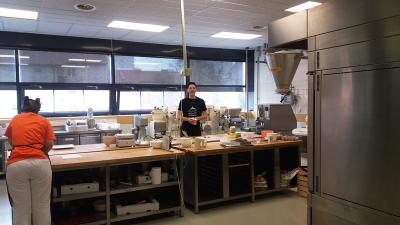
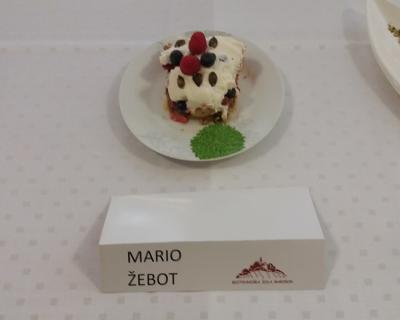
In the VISUAL ART category, student Tjaša Ploj achieved 4th place and a bronze award.
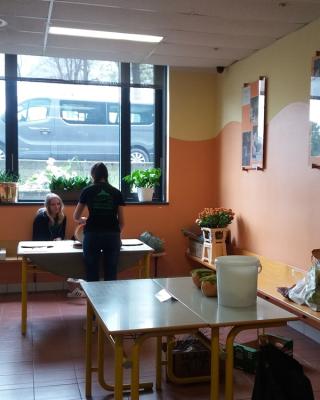
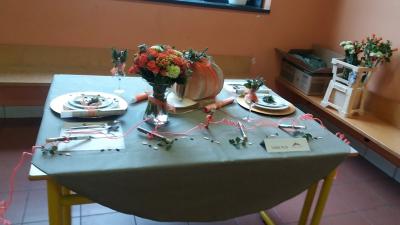
In the CONTRIBUTION/TEXT category student Mihael Unger reached the 8th place and a recognition for participation.
In the KNOWLEDGE category, Ivan Praznik achieved a silver award, while Jakob Pulko received a recognition for his participation.
In the category of PHOTOGRAPHY, Mihej Mukenauer achieved the 4th place and the silver award, while the student Nikita Lenarčič received a recognition for participation.
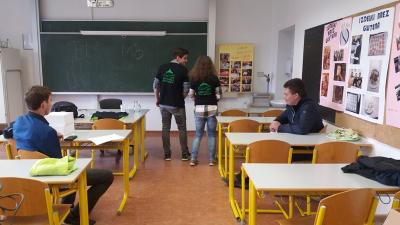
Congratulations to all students for the honors and praise for all the efforts and zeal you have invested in the competition.
... link (0 Kommentare) ... comment
The average monthly temperature was also significantly lower than the average of the period from 1981 to 2010, it was 3,35 °C, and it was 2,65 °C lower than the long-term average. The long-term average for March is 6 °C in Maribor. However, if we compare only the average temperature of the first week with the average of the period from 1981 to 2010, it was found that it was lower by as much as 8.78 °C.
In March, the average temperature was nine times below the freezing point (0 °C). The minimum daily temperature was seventeen days below the freezing point. The lowest temperature in March was - 19.8 °C, and the highest temperature was 16.3 °C.
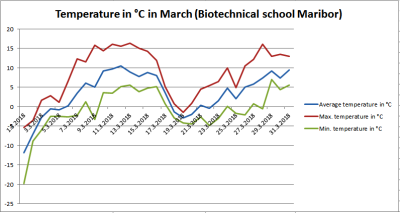
Precipitation data show that March was rich in precipitation. The first part of the month was a lot of snow, while in the second part there was rainy.
According to the data of the meteorological station in the center of Maribor, there was 54.9 cm of snowfall in March.
Precipitation during March was above average. The measuring device detected 87.4 mm of precipitation, which is much more as long as the long-term average (57 mm of precipitation).
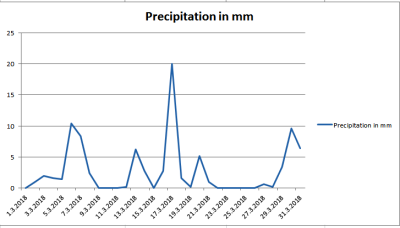
The average relative humidity in March was 77.6 %, which is 9 % less as in February.

... link (0 Kommentare) ... comment


We regularly observe bee colonies to see how they evolve. Bee families are in excellent condition. Begins as the period of intensive pesticide spraying, so we will need to monitor the behaviour of bees even more intensively.
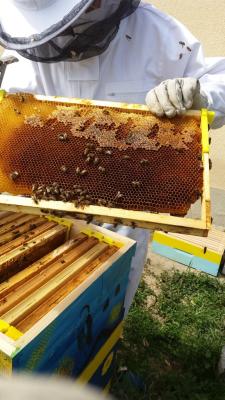
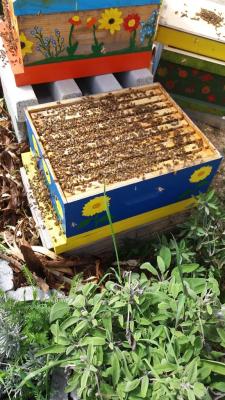

... link (1 Kommentar) ... comment
The Old Vine is pruned each year on the anniversary of the establishment of our school by Andrej Podjavoršek, a teacher of viticulture at our school, and Stane Kocutar, the city vinedresser.
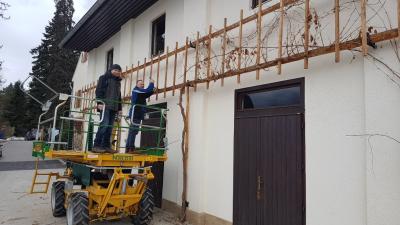
On Sunday, March 11, a small group of people attended the pruning. When the work was done, we tried last year's wine from the old vines.

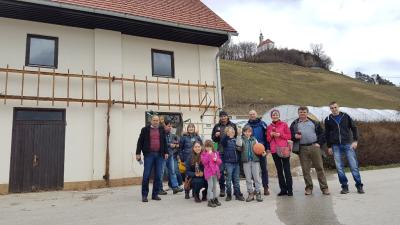
Everyone who was not present this year is invited to attend this event next year, on Monday, March 11, 2019.
... link (0 Kommentare) ... comment